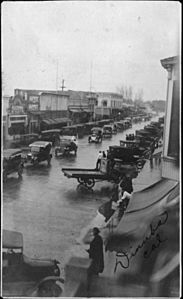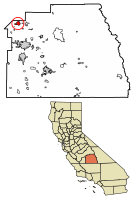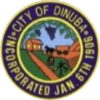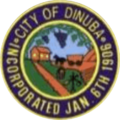Dinuba, California facts for kids
Quick facts for kids
Dinuba, California
|
|||
|---|---|---|---|

Local parade supporting the Korean March 1 Independence Movement (1920)
|
|||
|
|||
| Nicknames:
Raisin City, Raisinland U. S. A., Dina
|
|||
| Motto(s):
Together, A Better Community
|
|||

Location of Dinuba in Tulare County, California
|
|||
| Country | |||
| State | |||
| County | Tulare | ||
| Incorporated | January 6, 1906 | ||
| Area | |||
| • Total | 6.51 sq mi (16.86 km2) | ||
| • Land | 6.51 sq mi (16.86 km2) | ||
| • Water | 0.00 sq mi (0.00 km2) 0% | ||
| Elevation | 335 ft (102 m) | ||
| Population
(2020)
|
|||
| • Total | 24,563 | ||
| • Density | 3,773.12/sq mi (1,456.92/km2) | ||
| Time zone | UTC-8 (Pacific) | ||
| • Summer (DST) | UTC-7 (PDT) | ||
| ZIP code |
93618
|
||
| Area code | 559 | ||
| FIPS code | 06-19318 | ||
| GNIS feature IDs | 1658422, 2410342 | ||
Dinuba is a city located in Tulare County, California, in the United States. In 2020, about 24,563 people lived there. This was more than the 21,453 people counted in 2010. Dinuba is part of the larger Visalia-Porterville area.
You can learn about the city's past at the Alta District Museum. It's in an old railroad station and shows what life was like in Dinuba long ago.
No one is completely sure where the name "Dinuba" came from. Some people think it might be a misspelled word related to an ancient group called the Danubian people. Others believe railroad engineers just made up a fun name when they built the train line here. The city was first called Sibleyville, named after James Sibley. He gave 240 acres of land to the Pacific Improvement Company.
In the early 1900s, many Korean-Americans lived in Dinuba. In 1920, they held a parade to support Korea's independence from Japan. This parade celebrated the second anniversary of the March 1st Movement, a big independence movement in Korea.
Contents
Exploring Dinuba's Location and Land
Dinuba is located at 36°32′42″N 119°23′21″W / 36.54500°N 119.38917°W. It covers an area of about 6.5 square miles (16.8 square kilometers), and all of it is land.
The city's land is mostly flat, sitting about 335 feet (102 meters) above sea level. The ground gently slopes from the northeast to the southwest. Even the underground water flows in this direction. To the northeast of Dinuba, there are some small hills that reach heights of about 526 feet (160 meters).
Dinuba's Growing Population
Dinuba has grown a lot over the years! Here's how its population has changed:
| Historical population | |||
|---|---|---|---|
| Census | Pop. | %± | |
| 1910 | 970 | — | |
| 1920 | 3,400 | 250.5% | |
| 1930 | 2,968 | −12.7% | |
| 1940 | 3,790 | 27.7% | |
| 1950 | 4,971 | 31.2% | |
| 1960 | 6,103 | 22.8% | |
| 1970 | 7,917 | 29.7% | |
| 1980 | 9,907 | 25.1% | |
| 1990 | 12,743 | 28.6% | |
| 2000 | 16,844 | 32.2% | |
| 2010 | 21,453 | 27.4% | |
| 2020 | 24,563 | 14.5% | |
| U.S. Decennial Census | |||
Who Lives in Dinuba? (2010 Census)
In 2010, Dinuba had 21,453 people. Most people lived in homes, with only a small number in group housing or institutions.
The city is very diverse! About 84.4% of the people identified as Hispanic or Latino. Many different racial backgrounds make up the community, including White, African American, Native American, and Asian residents.
There were 5,593 households in Dinuba. Many of these (58.6%) had children under 18 living there. The average household had about 3.8 people. About 34.9% of the population was under 18 years old. The median age was 27.2 years, meaning half the people were younger and half were older than that.
Most homes were owned by the people living in them (56.8%). The rest were rented.
Dinuba's Businesses and Jobs
Dinuba is home to Ruiz Foods, a company that makes Mexican food. In 2003, then-President George W. Bush even visited the company to celebrate its 40th birthday!
Top Employers in Dinuba
Here are some of the biggest employers in Dinuba, based on a 2011 report:
| # | Employer | # of Employees |
|---|---|---|
| 1 | Ruiz Foods | 1,571 |
| 2 | Dinuba Unified School District | 768 |
| 3 | Family Tree Farms | 578 |
| 4 | Walmart | 400 |
| 5 | Best Buy | 330 |
| 6 | Odwalla | 200 |
| 7 | Giannini Packing | 180 |
| 8 | City of Dinuba | 159 |
| 9 | Apio Produce | 150 |
| 10 | Surabian & Sons Packing | 125 |
| 11 | Sadoian Bros. | 95 |
| 12 | Patterson Companies | 94 |
Famous People from Dinuba
Many interesting people have connections to Dinuba, including:
- Stephen H. Burum, a cinematographer (someone who works with cameras for movies)
- Cruz Bustamante, who was the 45th Lieutenant Governor of California
- Miguel Contreras, a farmworker and important labor leader
- Bryce Seligman DeWitt, a theoretical physicist
- Ike Frankian, an American football player
- Ester Hernandez, an artist known for her work in the Chicano Movement
- Dylan Lee, a relief pitcher for the Atlanta Braves baseball team
- Earl Kim, a Korean-American composer
- Russ Letlow, an NFL player for the Green Bay Packers
- Doris Matsui, a member of the United States House of Representatives, who grew up here
- William Michaelian, a novelist, short story writer, and poet
- Manuel Muñoz, a short story writer
- Oswald Hope Robertson, who started the world's first blood bank
- Burt Rutan, who designed famous aircraft like the Rutan Voyager and SpaceShipOne
- Claramae Turner, an opera singer and film actress
- Rose Ann Vuich, California's first woman State Senator
Sister Cities
Dinuba has special connections with cities in other countries, called "sister cities":
 Uruapan, Mexico
Uruapan, Mexico Malsch, Germany
Malsch, Germany
Images for kids
See also
 In Spanish: Dinuba para niños
In Spanish: Dinuba para niños









